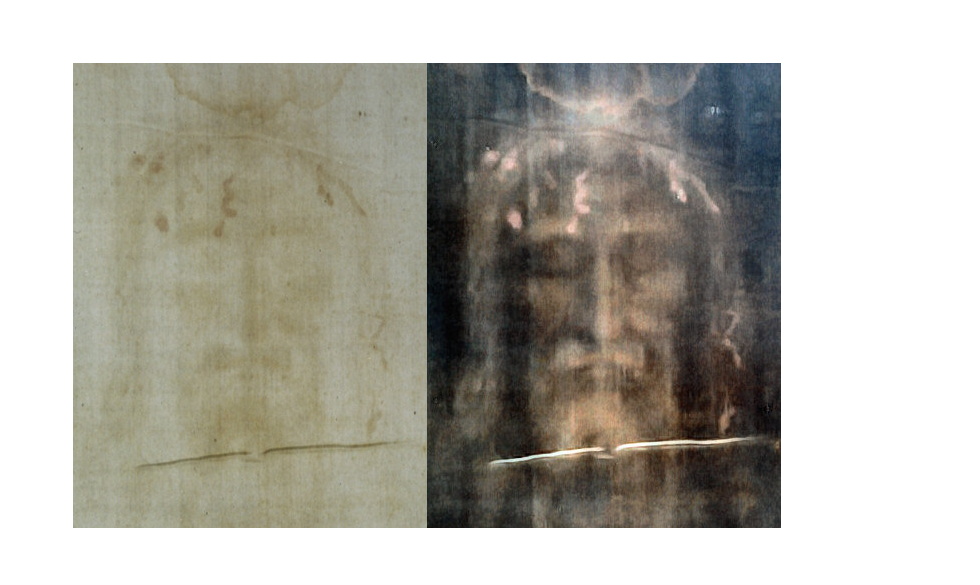“But in those times, it is known that many things occurred that are not written, as, for example, the linens and the sudarium in which the body of the Lord was wrapped. We read that it was found, but we do not read that it was preserved. Nevertheless, I do not believe that the relics would have been disregarded, but preserved for future times.”
That was written over 1000 years ago by St. Braulio of Zaragoza, Spain around 651 AD.1 So what are the linens that St. Braulio is refering to and why the controversy? The Shroud of Turin is believed to be the linen burial shroud Jesus was wrapped in after his crucifixion. It is believed that it was subsequently imprinted with his image during his resurrection. There has been much controversy on the Shroud of Turin. It must be a fake. After all, carbon dating determined it originated during the MIddle Ages. Wikipedia is very confident about this one (I have dropped the references in the quotes, all of which you can see if you go to the article here. Also note wiki entries often change. This quote is from March 26, 2021).
Diverse arguments have been made in scientific and popular publications claiming to prove that the cloth is the authentic burial shroud of Jesus, based on disciplines ranging from chemistry to biology and medical forensics to optical image analysis. However, all of the hypotheses put forward to challenge the radiocarbon dating have been scientifically refuted, including the medieval repair hypothesis, the bio-contamination hypothesis and the carbon monoxide hypothesis.
The image on the shroud is much clearer in black-and-white negative—first observed in 1898—than in its natural sepia colour. A variety of methods have been proposed for the formation of the image, but the actual method used has not yet been conclusively identified. The shroud continues to be both intensely studied and controversial.2

Upon reading these lines a quote came to mind: “For those who believe, no proof is necessary. For those who do not, no proof will suffice.” The Wikipedia contributor is clearly in the latter category. For those who are in the grey area between, this article is for you, to weigh the evidence that I will present. I would beg to differ on the point that the challenges to the radiocarbon dating, which have placed the origins of the Shroud between 1238 and 1430 AD, have been scientifically refuted. Nor would I agree with the assertion that scientific publications claim to prove the cloth is the authentic burial shroud of Jesus. It is impossible to prove using science that the Shroud of Turin was the authentic burial shroud of Jesus. No reasonable scientist would make such a claim! Instead I would point out that there are studies that have raised legitimate unresolved questions as to the accuracy, not of these dates or the dating techniques themselves, but of how this method was applied to the Shroud to date it. This is a subtle but very important distinction which I will explain further on.
What does scripture have to say about the burial cloths of Jesus? from John 20:6-8 “Then Simon Peter came, following him, and went into the tomb; he saw the linen cloths lying, and the napkin, which had been on his head, not lying with the linen cloths but rolled up in a place by itself. Then the other disciple, who reached the tomb first, also went in, and he saw and believed;”
Here we read that there was more than just one burial cloth. The napkin referred to in John, is what is now known as the Sudarium of Oviedo. Named after the Spanish town where it is currently kept, just as one or both of those linen cloths now is known as the Shroud of Turin, named after the French city where it currently resides.3
Now I’m sure once they entered the tomb, the first thing they would have done is investigate the tomb and the burial cloths. At that point they would notice the image on the Shroud.
Thus for John, “the image on the shroud was not only proof that Jesus had risen from the dead, but also that He was the Son of God, because only God would have created such an image.”4 This may also have been why John saw and believed.
If that is the case, why was the image on the Shroud not mentioned in the Gospel of John? One reason why the image of the Shroud may not have been mentioned was that It was forbidden by God for the Jewish people to, and I quote from Ex. 20:4, “make yourself a carved image or any likeness of anything in heaven or on earth beneath or in the waters under the earth”.5 Even more so forbidden to make an image of God. At that time the Shroud contained an image that was illegal and Sudarium blood that was considered impure.
What is the evidence that I find leads me to believe that the Shroud is very likely authentic? First it is as wikipedia states "The image on the shroud is much clearer in black-and-white negative—first observed in 1898—than in its natural sepia color." Indeed In 1898 Secondo Pia took two photographs of the shroud when it was on exposition in Turin. From the book The Mystery of the Shroud of Turin I quote John Iannone, “To his utter shock and amazement as the images on the shroud began to emerge Secondo noticed that they were developing as positives instead of negatives. The images as they appeared on the cloth were, therefore, negatives that when photographed produced positives. Conversely, the blood stains on the Shroud appeared in the photos as negatives whereas they are actually positives on the Shroud.”6 What the Wikipedia author fails to explicitly state is that the Shroud of Turin is actually a negative image. That is quite evident in the image on the left.
It is hard to imagine that a medieval artist - or forger - take your pick, could have come up with the idea of creating a negative. First because the concept of negative and positive images came with photography which is a very different process than any form of painting or sketching as it involves creating images with light and chemical processes rather than paint or other physical media. Furthermore, humans typically see the world in colour, as achromatopsia, which is typically complete loss of colour vision, is quite rare affecting one in 30,0007, and colour negatives are very different from black and white ones. If this were a medieval creation, would there not be other examples of this kind of artwork or forgery, assuming it was made by human hands? So what is the medium that has created this image? John C. Iannone, states "...study of the Shroud by artists has helped to eliminate any question that the Shroud was 'painted' - the formation of the images remaining as a great mystery"8
 In 2000 Joseph G. Marino and M. Sue Benford published the paper Evidence of the Skewing of the C14 Dating of the Shroud of Turin Due to Repairs. Unlike many other attempts to explain the inconsistency between the carbon dating and the traditionally accepted date of the Shroud, their theory is very simple and elegant. They allege there was no problem with the dating techniques used but instead the problem was with how the samples were chosen from the Shroud for dating. In this paper they suggest that along with historical records of the Shroud being repaired there is the possibility of undocumented repairs and,
In 2000 Joseph G. Marino and M. Sue Benford published the paper Evidence of the Skewing of the C14 Dating of the Shroud of Turin Due to Repairs. Unlike many other attempts to explain the inconsistency between the carbon dating and the traditionally accepted date of the Shroud, their theory is very simple and elegant. They allege there was no problem with the dating techniques used but instead the problem was with how the samples were chosen from the Shroud for dating. In this paper they suggest that along with historical records of the Shroud being repaired there is the possibility of undocumented repairs and,
we believe that the theory that the Shroud has literally been patched with medieval material from the 16th century, in the C-14 sample itself, explains the medieval carbon dating results. Furthermore, several other sindonologists have identified various anomalies that also seem to point to undocumented repairs, which adds credence to the hypothesis that the C-14 sample area may have been similarly enhanced.9
They noted that of the two samples dated in Oxford and Zurich, the fact that the Zurich sample had a more recent dating is consistent with the fact that it also had a larger proportion of what they believed to be more recent material in it. In the case of the two samples dated in Arizona they were unable to determine on what ends each of the dated samples were located. Thus the question marks. However If their theory is correct then the sample with the 1238 date should have been cut from the left end and the sample with the 1430 date should have been taken from the right end of the original sample taken from the Shroud (Figure 2). In addition when placed in this arrangement all the samples date consistently, given the hypothesized combination of older and more recent material (yellow and pink respectively).
Marino and Benford go on to point out in their paper: "Giovanni Riggi, the person who actually cut the C-14 sample, which was from the same area from which the 1973 'Raes piece' was taken, stated: I was authorized to cut approximately 8 square centimetres of cloth from the Shroud...This was then reduced to about 7 cm because fibres of other origins had become mixed up with the original fabric ..."10
Raymond Rogers, a scientist at the Los Alamos National Laboratory, who was part of the shroud of turin research project (STRUP) read their paper and was determined to prove them wrong. For his study he "received samples of both warp and weft threads that Prof. Luigi Gonella had taken from the radiocarbon sample before it was distributed for dating. Gonella reported that he excised the threads from the center of the radiocarbon sample." Using a different line of analysis from Marino and Benford, he came to the conclusion "The radiocarbon date was thus not valid for determining the true age of the shroud."11
One of the things Rogers did was to examine the vanillin content of lignin in order to date the samples. The vanillin content of the lignin in the linen of the Shroud decreases with time. (Lignin is an amorphous polymer related to cellulose that provides rigidity and together with cellulose forms the woody cell walls of plants and the cementing material between them.12 Linen is made from the plant flax which contains lignin.) He found that "The disappearance of all traces of vanillin from the lignin in the shroud indicates a much older age than the radiocarbon laboratories reported...Because the shroud and other very old linens do not give the vanillin test, the cloth must be quite old. It is thus very unlikely that the linen was produced during medieval times"13
 Back to the napkin, or what is now believed to be the Sudarium of Oviedo, referred to in John (Figure 3). After Jesus died his face was covered. The cloth used to cover his face was this Sudarium and was put on while he was still vertical on the cross. It was rewrapped after he had been taken down and laid horizontal, changing the pattern of blood stains on it. It remained in place while he was transported to a nearby location, and was then removed and placed aside. It most definitely did not remain in place underneath the shroud.14 Janice Bennett, in her book Sacred Blood, Sacred Image The Sudarium of Oviedo: “new research establishes approximately 20 points of correlation [between the Shroud and the Sudarium], which more than satisfies the standards of proof used by most judicial systems around the world, which require only 8 to 10.”15
Back to the napkin, or what is now believed to be the Sudarium of Oviedo, referred to in John (Figure 3). After Jesus died his face was covered. The cloth used to cover his face was this Sudarium and was put on while he was still vertical on the cross. It was rewrapped after he had been taken down and laid horizontal, changing the pattern of blood stains on it. It remained in place while he was transported to a nearby location, and was then removed and placed aside. It most definitely did not remain in place underneath the shroud.14 Janice Bennett, in her book Sacred Blood, Sacred Image The Sudarium of Oviedo: “new research establishes approximately 20 points of correlation [between the Shroud and the Sudarium], which more than satisfies the standards of proof used by most judicial systems around the world, which require only 8 to 10.”15
So the question: Is the Shroud of Turin the real deal? Science cannot definitively prove that it is. But so far there is evidence that supports the notion that it is very old...and there are aspects of it that science can probably never answer such as how was the image formed? What media was used to create it? But this is what one might expect if it were formed during the resurrection of Christ...one of many miracles that he worked. And a miracle typically goes far beyond what science can explain. Faith and reason can go hand in hand - one takes over when the other reaches its limits.
References
Blog image credit: Dianelos Georgoudis, Wikimedia
1. Janice Bennett, Sacred Blood, Sacred Image the Sudarium of Oviedo, Ignatius Press, 2001, p. 19
2. https://en.wikipedia.org/wiki/Shroud_of_Turin
3. Janice Bennett, Sacred Blood, Sacred Image the Sudarium of Oviedo, Ignatius Press, 2001, p. 22
4. Ibid, p. 163
5. Ibid, p. 163
6. John C. Iannone, The Mystery of the Shroud of Turin, St. Pauls, 1998, p. 5
7. http://www.essentialvermeer.com/technique/perspective/history.html
8. John C. Iannone, The Mystery of the Shroud of Turin, St. Pauls, 1998, p. 145.
9. J. G. Marino, M. S. Benford, Evidence for the Skewing of the C-14 Dating of the Shroud of Turin Due to Repairs.
10. Ibid
11. Raymond N. Rogers, Studies on the radiocarbon sample from the shroud of turin, thermochimica acta, 2005, pp. 189-194.
12. https://www.merriam-webster.com/dictionary/lignin
13. Raymond N. Rogers, Studies on the radiocabon sample from the shroud of turin, thermochimica acta, 2005, p. 191.
14. Janice Bennett, Sacred Blood, Sacred Image the Sudarium of Oviedo, Ignatius Press, 2001, p. 15
15. Ibid






